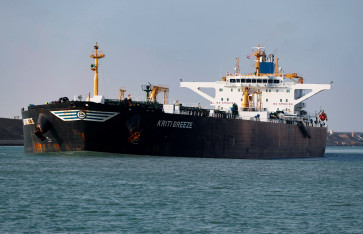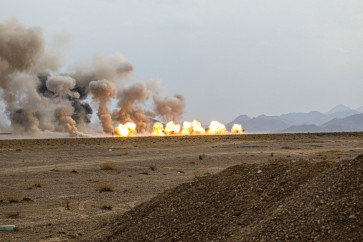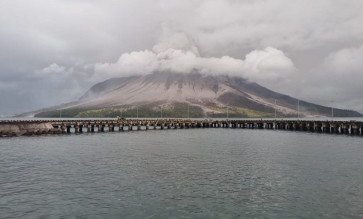Dry season inflicts hotspots in Riau, S. Sumatra and drought in NTT
High and dry: Residents line up to collect water dregs from the dried up Cenang River in Sigerung hamlet, Jatimulya village, Tegal regency, Central Java, on Friday
Change Size
 High and dry: Residents line up to collect water dregs from the dried up Cenang River in Sigerung hamlet, Jatimulya village, Tegal regency, Central Java, on Friday. Residents have been having difficulty in getting clean water over the past two weeks as a result of the dry season.(Antara/Oky Lukmansyah) (Antara/Oky Lukmansyah)
High and dry: Residents line up to collect water dregs from the dried up Cenang River in Sigerung hamlet, Jatimulya village, Tegal regency, Central Java, on Friday. Residents have been having difficulty in getting clean water over the past two weeks as a result of the dry season.(Antara/Oky Lukmansyah) (Antara/Oky Lukmansyah)
H
span class="inline inline-center">High and dry: Residents line up to collect water dregs from the dried up Cenang River in Sigerung hamlet, Jatimulya village, Tegal regency, Central Java, on Friday. Residents have been having difficulty in getting clean water over the past two weeks as a result of the dry season.(Antara/Oky Lukmansyah)
The dry season has been blamed for a further increase in the number of hotspots ' which can trigger forest and land fires ' in Riau and South Sumatra and for drought in East Nusa Tenggara (NTT).
Based on data gathered by the Pekanbaru Meteorology, Climatology and Geophysics (BMKG) station on Friday, 86 hotspots were detected in Riau, a significant increase from Wednesday's 64 hotspots and Thursday's 46.
Pekanbaru BMKG Data and Information section head Slamet Riyadi said the hotspots were currently found in 10 regencies and cities in Riau.
'Only Pekanbaru city and Meranti Islands regency are still free of hotspots,' said Slamet.
The greatest number of hotspots is currently found in Pelalawan regency, with 21, followed by Rokan Hilir, 17, Kuantan Singingi, 15, Indragiri Hilir, 11, Siak, six, Bengkalis, five, Dumai and Indragiri Hulu, four each, and Rokan Hulu with three.
'As many as 25 of them have been identified as fire spots, we are more than 70 percent confident, with seven of those in Kuantan Singingi, seven in Rokan Hilir, three in Indragiri Hulu and two in each of Dumai, Pelalawan and Rokan Hilir,' Slamet added.
The increase in the number of hotspots is attributed to minimum rainfall and high temperatures prevailing in every regency and city across the province. According to Slamet, the weather in Riau is generally cloudy and the average maximum temperature is 35 degrees Celsius. The dry season, he added, was expected to last until August.
The presence of the hotspots has started to affect visibility in several regencies and cities. Visibility in Pekanbaru was recorded at 5 kilometers, in Pelalawan and Rengat, 4 km, and Dumai, 7 km. 'The air quality is categorized as moderate,' he said.
The Riau Haze Emergency Response Command and the Agency for the Assessment and Application of Technology (BPPT) are making efforts to reduce the hotspots with cloud seeding.
'Since June 22, we have been conducting cloud seeding, by scattering tons of salt over the clouds in Riau to induce rain,' said BPPT artificial rain technical head Heru Widodo.
Meanwhile, the South Sumatra BMKG Observation and Information head Indra Purnama said his agency detected dozens of hotspots in eight regencies and cities: Ogan Komering Ilir, Banyuasin, Musi Banyuasin, Muaraenim, Ogan Komering Ulu and East Ogan Komering regencies and Lubuklinggau city.
'The number of hotspots may likely be higher than found in other regions, as the temperature in our province tends to rise while rainfall has dropped drastically in June to between 101 and 200 millimeters, compared with the previous month's 400 mm,' said Indra.
Separately, the NTT administration reported that 17 regencies in the province were at risk of drought following the El Niño heat wave, predicted to occur from June to November this year.
NTT Agriculture and Plantation Office head Yohanes Tay Ruba said regencies prone to the El Niño weather phenomenon were Kupang, South Central Timor, North Central Timor, Belu, Malaka, Sikka, Ende, Nagekeo and East Flores.
Kupang Regent Ayub Titu Eki claimed he had anticipated the drought in the regency by urging the community to grow long-term and short-term crops through the high intensity farming program.
'The most important thing is the change in people's behavior toward growing all types of plants. The yields will be enjoyed by the community. The government just encourages farmers and provides them with seedlings,' said Ayub.









